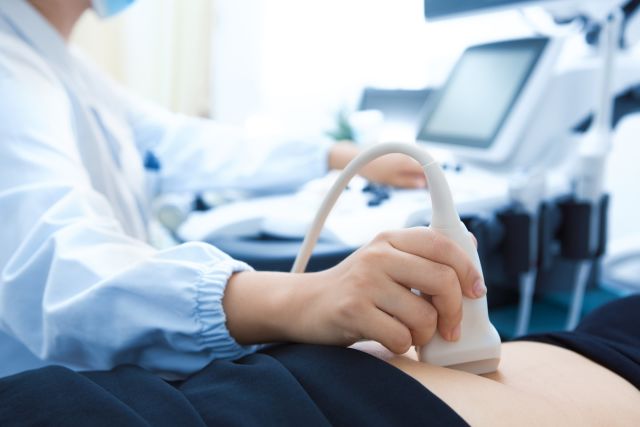Updated on February 1, 2023.
When Hailey Bieber revealed that she experienced recurring ovarian cysts, it cast new light on a common health issue. The 26-year-old revealed that her sizeable cysts were not only painful, but also resulted in uncomfortable symptoms, including bloating and nausea.
"I have a cyst on my ovary the size of an apple," the 26-year-old wrote on her Instagram story in November 2022. Bieber clarified that she does not have endometriosis or polycystic ovary syndrome (PCOS), “but I have gotten an ovarian cyst a few times and it's never fun." She pointed out that many people could “overly relate and understand.”
It’s true. Ovarian cysts are relatively common. Research suggests they affect anywhere from 8 to 18 percent of women. But that percentage may be even higher, according to Catherine Chan, MD, an OB/GYN with expertise in minimally invasive surgery at New York University Langone Health in New York City. In many cases, ovarian cysts may go unnoticed and unreported, Dr. Chan explains.
Unlike Bieber, some people do not experience pain, discomfort, or other issues. In fact, most people with regular periods develop tiny ovarian cysts every month during their menstrual cycle, which resolve on their own without treatment, Chan points out.
Most ovarian cysts that are detected are found incidentally during routine pelvic exams or on pelvic imaging exams being performed for other reasons.
What is an ovarian cyst—and why do they form?
An ovarian cyst is a sac filled with fluid or other tissue that forms in or on the ovary, according to Chan. The ovaries are two almond-sized organs on either side the uterus that release an egg each month during the menstrual cycle.
Ovarian cysts can be separated into two categories, depending on how they form, Chan says. Functional cysts, which are the most common, grow in relation to regular menstrual cycles. They can actually indicate that the ovaries are working as they should. Functional cysts can be further broken down into two types: follicular and corpus luteum.
Eggs grow or mature inside a very small sac called an ovarian follicle. Once an egg is released, the sac usually shrinks and begins producing estrogen and progesterone—hormones needed for conception. But sometimes, a cyst may form if an egg isn’t released (follicular cyst) or if the sac closes back up after releasing an egg (corpus luteum cyst).
Follicular cysts usually do not cause symptoms, and typically go away on their own within one to two months. Corpus luteum cysts, on the other hand, are always found during early pregnancy as they secrete hormones to support the embryo until the placenta takes over. They usually resolve on their own by the end of the first trimester, although they sometimes persist even longer. They can also develop in people who are not pregnant and grow quite large—up to four inches in diameter—and may cause symptoms, but they usually go away on their own within six to eight weeks.
Other less common types of ovarian cysts (unrelated to periods) may be based on a person’s age and underlying medical issues, including:
Teratomas: These benign growths may develop when fully developed tissue, such as hair, skin, or teeth, collects in a fluid-filled sac on the ovary. They can be present at birth (also called dermoid cysts) and typically occur in people who have not yet gone through menopause. They are usually removed surgically. If left untreated, they can lead to complications, particularly if they grow too large. Very rarely, they can become cancerous.
Cystadenoma: This is a tumor that forms on the surface of the ovary. They can grow very large, but they are usually benign or not cancerous.
Why do some people get ovarian cysts?
Hormone fluctuations that occur during a typical menstrual cycle are the most common cause of ovarian cysts. But aside from these hormonal swings, other factors could increase your risk for ovarian cysts include:
- Certain medications, such as fertility drugs that induce ovulation or tamoxifen (chemotherapy for breast cancer)
- PCOS—a hormonal condition that also increases the risk for health problems, including diabetes and heart disease
- Endometriosis—a condition that develops when cells that line the inside of the uterus grow outside the uterus
- Pregnancy
- Smoking
- Tubal ligation, or getting your “tubes tied”
Signs of a more serious issue
Most ovarian cysts, which range in size from one to two inches, resolve on their own without treatment. But they can grow bigger. “Healthcare providers are usually concerned when ovarian cysts reach four inches in size,” Chan says, noting most healthcare providers will consider other factors including what the cyst looks like on imaging tests, and whether a patient is experiencing symptoms.
If an ovarian cyst grows large enough to press on other organs, such as the bladder or intestines, it can cause symptoms. “People with symptomatic ovarian cysts typically experience pain or pressure in the lower abdomen on the side of the cyst,” Chan adds. “The pain may be dull or sharp, constant or inconsistent.”
Perhaps surprisingly, most ovarian cysts do not cause irregular periods, Chan points out. But some people may also need to urinate more often or have trouble completely emptying their bladder or bowels. Other symptoms may include:
- Bloating
- Unexplained weight gain
- Breast tenderness
- Pain during menstruation
- Pain during sex
Very rarely, ovarian cysts that grow very large can cause twisting of an ovary (called ovarian torsion). This is a medical emergency that requires immediate attention. If not treated promptly, this twisting which can block blood supply to the ovary, may result in damage or death of ovary cells.
Warning signs of ovarian torsion include sudden, severe pain on one side, as well as nausea and vomiting.
Some ovarian cysts also have the potential to rupture or burst. The possibility for rupture is higher in people of reproductive age, with larger cysts, and after strenuous activity, according to Chan. “Ovarian cyst rupture is usually associated with sudden onset of sharp pain which can be quite severe,” she says.
Symptoms of a ruptured ovarian cyst may also include nausea or vomiting. It’s possible that a ruptured ovarian cyst may result in mild to moderate internal bleeding. In most cases, bleeding from an ovarian cyst stops on its own without surgery. The body usually reabsorbs the blood over the course of a few weeks, which can cause lingering abdominal pain or discomfort while the problem resolves, according to Chan.
In rare cases, internal bleeding from a ruptured cyst may become severe enough to require surgery or cause life-threatening shock with additional symptoms such as cold, clammy skin, rapid breathing, lightheadedness, or weakness.
It’s possible for certain types of ovarian cysts to become cancerous, but this is also very rare, according to Chan. In fact, less than 1 percent of new ovarian growths are related to ovarian cancer, although the risk is slightly increased in people who are past menopause.
Anyone who suspects they may have an ovarian cyst or is experiencing uncomfortable symptoms should not hesitate to visit their healthcare provider for guidance. “If you have particular questions regarding ovarian cysts, definitely make an appointment with your gynecologist to get the conversation started,” Chan says.
Treatment options for ovarian cysts
Only about 8 percent of premenopausal people with large cysts need treatment, which can depend on their age, symptoms, and the type of cyst they have.
For those with small ovarian cysts who do not have symptoms, treatment may simply consist of “watchful waiting.” This involves monitoring symptoms and may include repeating ultrasounds at regular intervals. For people who are past menopause, however, cysts may be less likely to go away on their own. In these cases, the decision about watchful waiting may depend on blood tests, how the cyst looks on ultrasound, and other factors.
People who experience symptoms may have an ultrasound to confirm the presence of a cyst, Chan says, noting their “healthcare provider may recommend other imaging studies or blood tests to provide more information.”
Painful cysts may be treated with over-the-counter (OTC) or prescription pain medications. Birth control pills could also help prevent new cysts from forming (but they won’t shrink the size of an existing cyst).
For cysts that grow very large, change in appearance, do not go away on their own, cause significant symptoms, or look suspicious for cancer, surgery is an option.
Many cysts can be removed with minimally invasive laparoscopic surgery, which uses surgical instruments inserted through small cuts in the abdomen. If the cyst is large or cancer is suspected, open surgery is usually performed.






